Multiarea Voltage Controller for Active Distribution Networks
Abstract
:1. Introduction
2. Network Partitioning and Control Bus Selection
2.1. Partitioning Procedure
2.2. Pilot Bus Selection
3. Mathematical Formulation of the Area Voltage Control Problem
3.1. Control Variables
3.2. The Objective Function
3.2.1. Network Reduction
3.2.2. Voltage Regulation
3.2.3. The Overall Objective Function
3.3. Dynamic Inequality Constraints
3.4. The Optimal Problem
4. Test Results
4.1. Test 1—High Loads and Low PV Generations
- -
- is the 3-dimensional column vector of unknown voltage phases which can be defined as: .
- -
- is the -dimensional equivalent admittance matrix of the reduced network model, which can be expressed as:
- -
- is the 2-dimensional column vector of the reactive power outputs of PV systems which can be expressed as: .
4.2. Test 2—Impact of the Noise on the Voltage Control
4.3. Test 3—Low Loads and High PV Generations
4.4. Test 4—Transient Event
5. Discussion
6. Conclusions
Author Contributions
Conflicts of Interest
References
- Vita, V.; Alimardan, T.; Ekonomou, L. The impact of distributed generation in the distribution networks’ voltage profile and energy losses. In Proceedings of the 9th IEEE European Modelling Symposium on Mathematical Modelling and Computer Simulation, Madrid, Spain, 6–8 October 2015; pp. 260–265. [Google Scholar]
- Ch, Y.; Goswami, S.K.; Chatterjee, D. Effect of network reconfiguration on power quality of distribution system. Int. J. Electr. Power Energy Syst. 2016, 83, 87–95. [Google Scholar] [CrossRef]
- Vita, V. Development of a decision-making algorithm for the optimum size and placement of distributed generation units in distribution networks. Energies 2017, 10, 1433. [Google Scholar] [CrossRef]
- Gopiya-Naik, S.; Khatod, D.K.; Sharma, M.P. Optimal allocation of distributed generation in distribution system for loss reduction. In Proceedings of the IACSIT Coimbatore Conferences, Coimbatore, India, 18–19 February 2012; Volume 28, pp. 42–46. [Google Scholar]
- Kaur, N.; Jain, S.K. Multi-Objective Optimization Approach for Placement of Multiple DGs for Voltage Sensitive Loads. Energies 2017, 10, 1733. [Google Scholar] [CrossRef]
- Kayal, P.; Chanda, C.K. Placement of Wind and Solar Based DGs in Distribution System for Power Loss minimization and voltage stability improvement. Int. J. Electr. Power Energy Syst. 2013, 53, 795–809. [Google Scholar] [CrossRef]
- Bruno, S.; Dassisti, M.; la Scala, M.; Chimienti, M.; Stigliano, G.; Palmisani, E. Managing Networked Hybrid-Energy Systems: A Predictive Dispatch Approach. In Proceedings of the IFAC, Cape Town, South Africa, 24–29 August 2014; Volume 47, pp. 2394–2399. [Google Scholar]
- Eremia, M.; Tawfeeq, A.B.L. Reactive power optimization based on genetic algorithm with new technique of mutation. In Proceedings of the 2014 International Symposium on Fundamentals of Electrical Engineering (ISFEE), Bucharest, Romania, 28–29 November 2014; pp. 1–5. [Google Scholar]
- Cagnano, A.; Torelli, F.; Alfonzetti, F.; de Tuglie, E. Can PV plants provide a reactive power ancillary service? A treat offered by an on-line controller. Renew. Energy 2011, 36, 1047–1052. [Google Scholar] [CrossRef]
- De Tuglie, A.C.E.; Liserre, M.; Mastromauro, R.A. Online optimal reactive power control strategy of PV inverters. IEEE Trans. Ind. Electron. 2011, 58, 4549–4558. [Google Scholar]
- Bolognani, S.; Zampieri, S. A distributed control strategy for reactive power compensation in smart microgrids. IEEE Trans. Autom. Control 2013, 58, 2818–2833. [Google Scholar] [CrossRef]
- Ahn, C.; Peng, H. Decentralized voltage control to minimize distribution power loss of microgrids. IEEE Trans. Smart Grid 2013, 4, 1297–1304. [Google Scholar] [CrossRef]
- Delfino, F.; Denegri, G.B.; Invernizzi, M.; Procopio, R. An Integrated Active and Reactive Power Control Scheme for Grid-Connected Photovoltaic Production Systems. In Proceedings of the IEEE 39th Power Electronics Specialists Conference PESC, Rhodes, Greece, 15–19 June 2008. [Google Scholar]
- Cagnano, A.; de Tuglie, E.; Dicorato, M.; Forte, G.; Trovato, M. PV plants for voltage regulation in distribution networks. In Proceedings of the 2012 47th International Universities Power Engineering Conference (UPEC), London, UK, 4–7 September 2012; pp. 1–5. [Google Scholar]
- Malekpour, A.R.; Pahwa, A. Reactive Power and Voltage Control in Distribution Systems with Photovoltaic Generation. In Proceedings of the North American Power Symposium (NAPS) 2012, Champaign, IL, USA, 9–11 September 2012. [Google Scholar]
- Cagnano, A.; de Tuglie, E. Centralized voltage control for distribution networks with embedded PV systems. Renew. Energy 2015, 76, 173–185. [Google Scholar] [CrossRef]
- Bronzini, M.; Bruno, S.; la Scala, M.; Sbrizzai, R. Coordination of active and reactive distributed resources in a smart grid. In Proceedings of the IEEE Trondheim PowerTech, Trondheim, Norway, 19–23 June 2011; pp. 1–7. [Google Scholar]
- Aristidou, P.; Olivier, F.; Hervas, M.E.; Ernst, D.; van Cutsem, T. Distributed Model-Free control of photovoltaic units for mitigating overvoltages in low voltage networks. In Proceedings of the CIRED 2014 Workshop “Challenges of implementing Active Distribution System Management”, Rome, Italy, 11–12 June 2014. [Google Scholar]
- Carvalho, P.M.S.; Correia, P.F.; Ferreira, L.A.F.M. Distributed reactive power generation control for voltage rise mitigation in distribution networks. IEEE Trans. Power Syst. 2008, 23, 766–772. [Google Scholar] [CrossRef]
- Fakham, H.; Ahmidi, A.; Colas, F.; Guillaud, X. Multi-agent system for distributed voltage regulation of wind generators connected to distribution network. In Proceedings of the 2010 IEEE PES Innovative Smart Grid Technologies Conference Europe (ISGT Europe), Gothenberg, Sweden, 11–13 October 2010; pp. 1–6. [Google Scholar]
- Fallahzadeh-Abarghouei, H.; Nayeripour, M.; Hasanvand, S.; Waffenschmidt, E. Online hierarchical and distributed method for voltage control in distribution smart grids. IET Gener. Transm. Distrib. 2017, 11, 1223–1232. [Google Scholar] [CrossRef]
- Saravanakathir, B.; Sasiraja, R.M. Optimal Coordinated Voltage Control Method for Distribution Network in Presence of Distributed Generators. Int. J. Eng. Sci. 2017, 7, 12117–12122. [Google Scholar]
- Bahramipanah, M.; Cherkaoui, R.; Paolone, M. Decentralized voltage control of clustered active distribution network by means of energy storage systems. Electr. Power Syst. Res. 2016, 136, 370–382. [Google Scholar] [CrossRef]
- Nayeripour, M.; Fallahzadeh-Abarghouei, H.; Waffenschmidt, E.; Hasanvand, S. Coordinated online voltage management of distributed generation using network partitioning. Electr. Power Syst. Res. 2016, 141, 202–209. [Google Scholar] [CrossRef]
- Sun, H.; Guo, Q.; Zhang, B.; Wu, W.; Wang, B. An adaptive zone-division-based automatic voltage control system with applications in China. IEEE Trans. Power Syst. 2013, 28, 1816–1828. [Google Scholar] [CrossRef]
- Morattab, A.; Akhrif, O.; Saad, M. Decentralised coordinated secondary voltage control of multi-area power grids using model predictive control. IET Gener. Transm. Distrib. 2017, 11, 4546–4555. [Google Scholar] [CrossRef]
- De Tuglie, E.; Iannone, S.M.; Torelli, F. A coherency recognition based on structural decomposition procedure. IEEE Trans. Power Syst. 2008, 23, 555–563. [Google Scholar] [CrossRef]
- Milano, F. Power System Modelling and Scripting; Springer: Berlin, Germany, 2010. [Google Scholar]
- Passoni, S. Partecipazione dei Generatori al Controllo Della Tensione Sulla Rete BT. Available online: http://hdl.handle.net/10589/49301 (accessed on 15 June 2012).
- The Math Works. Matlab/Simulink User’s Guide; The Math Works: Natick, MA, USA, 2016. [Google Scholar]
- European Committee for Electrotechnical Standardization. EN 50160: Voltage Characteristics of Electricity Supplied by Public Distribution Systems; European Committee for Electrotechnical Standardization: Brussels Belgium, 1999. [Google Scholar]
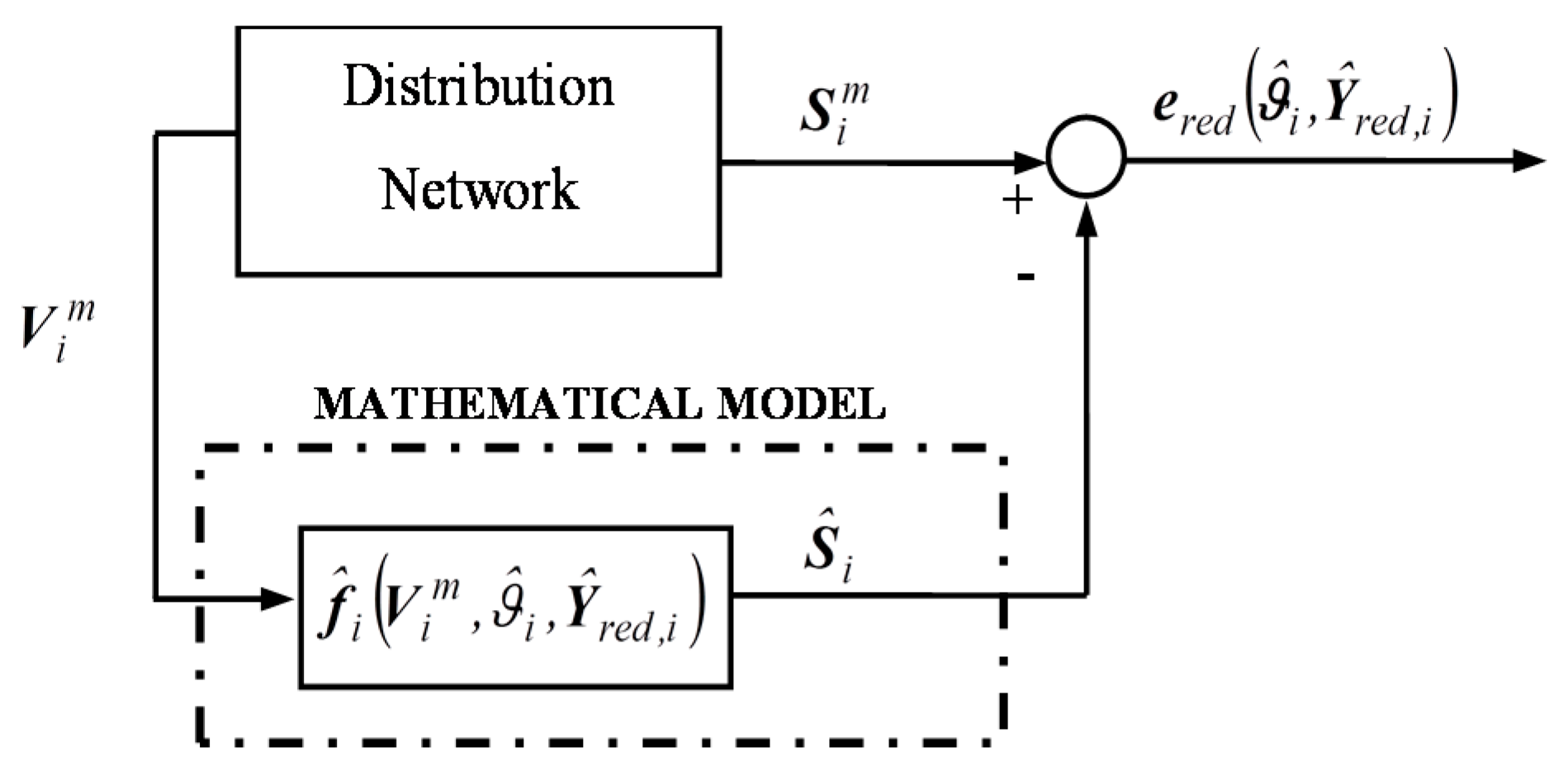
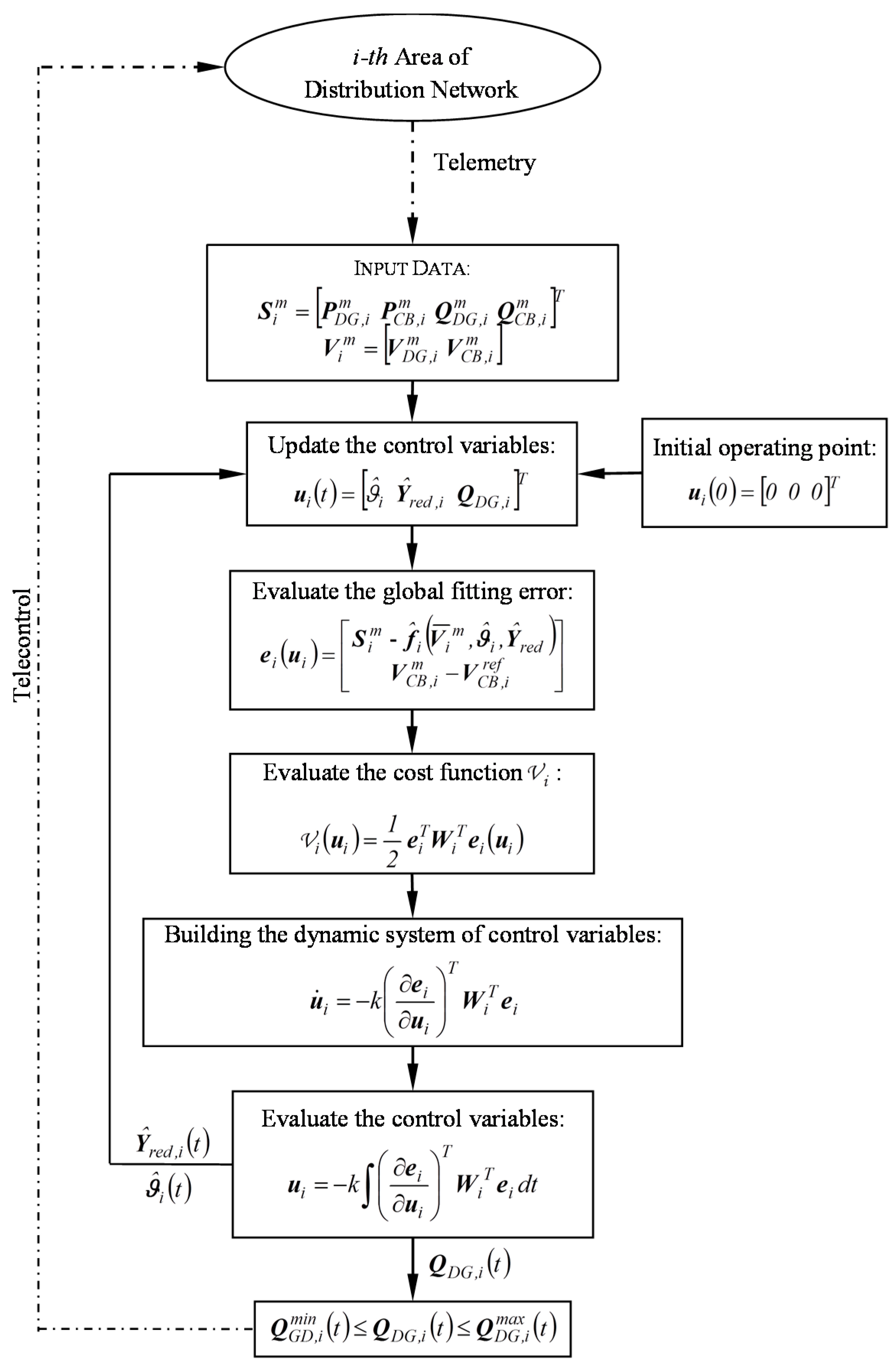
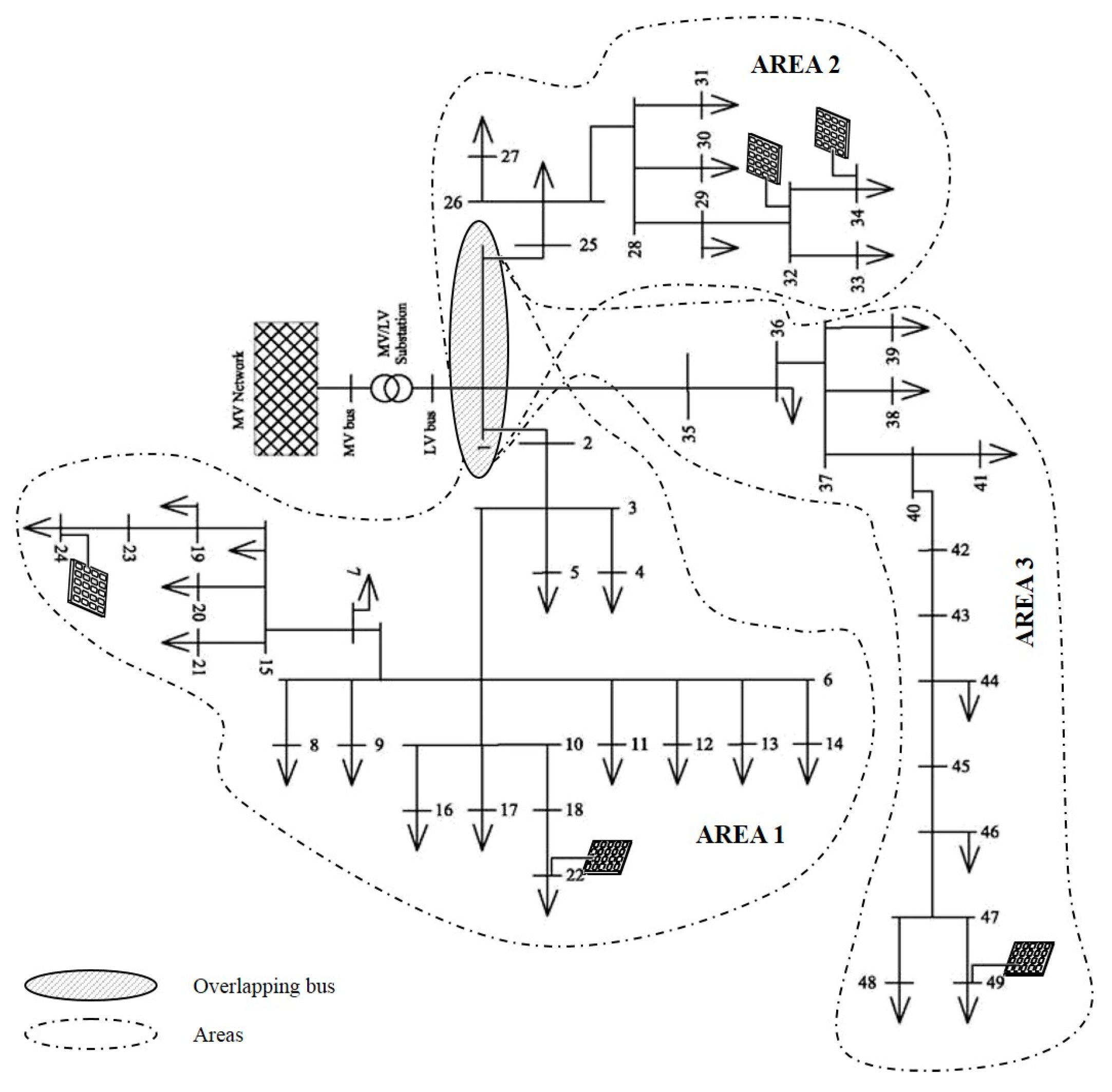
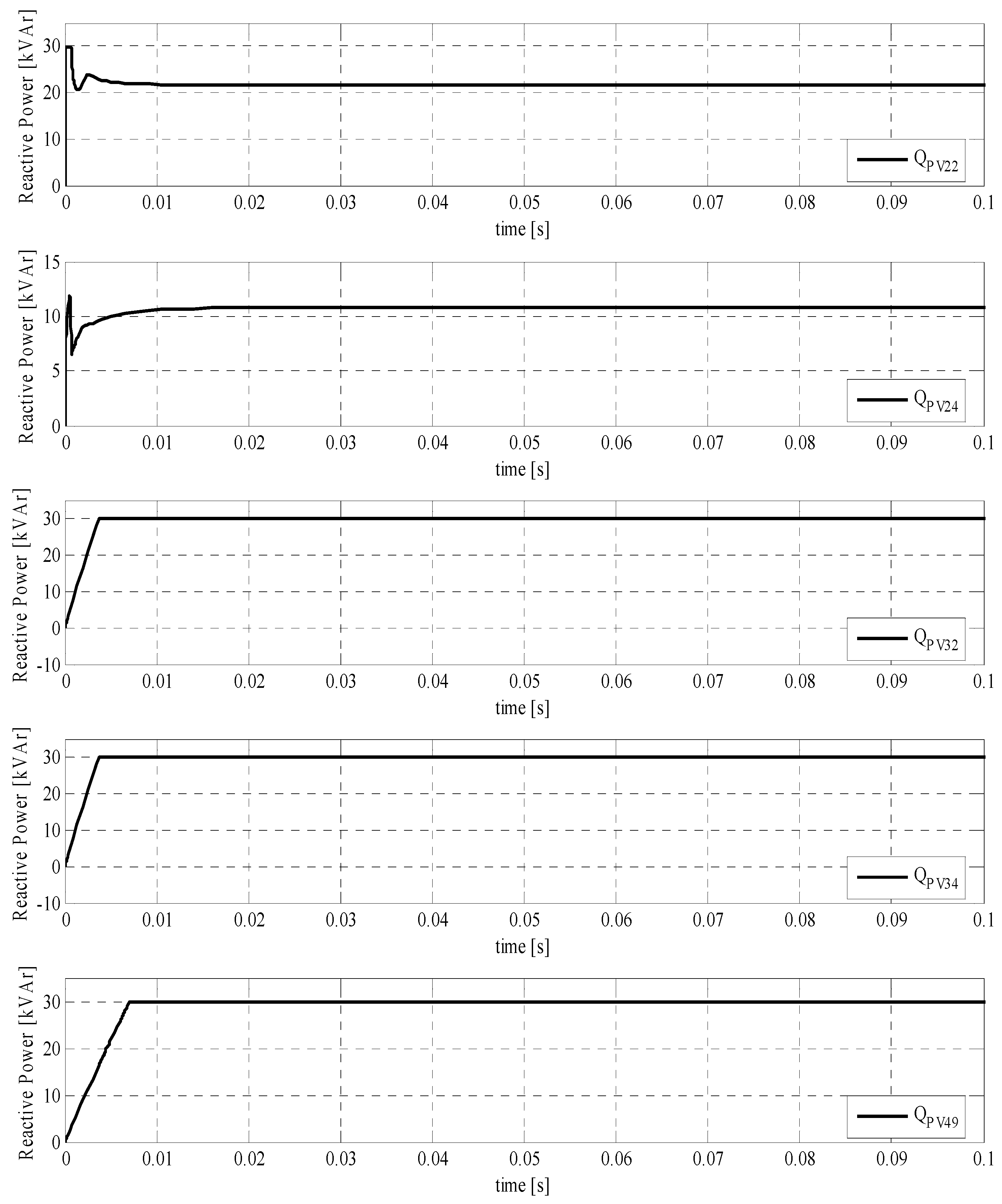
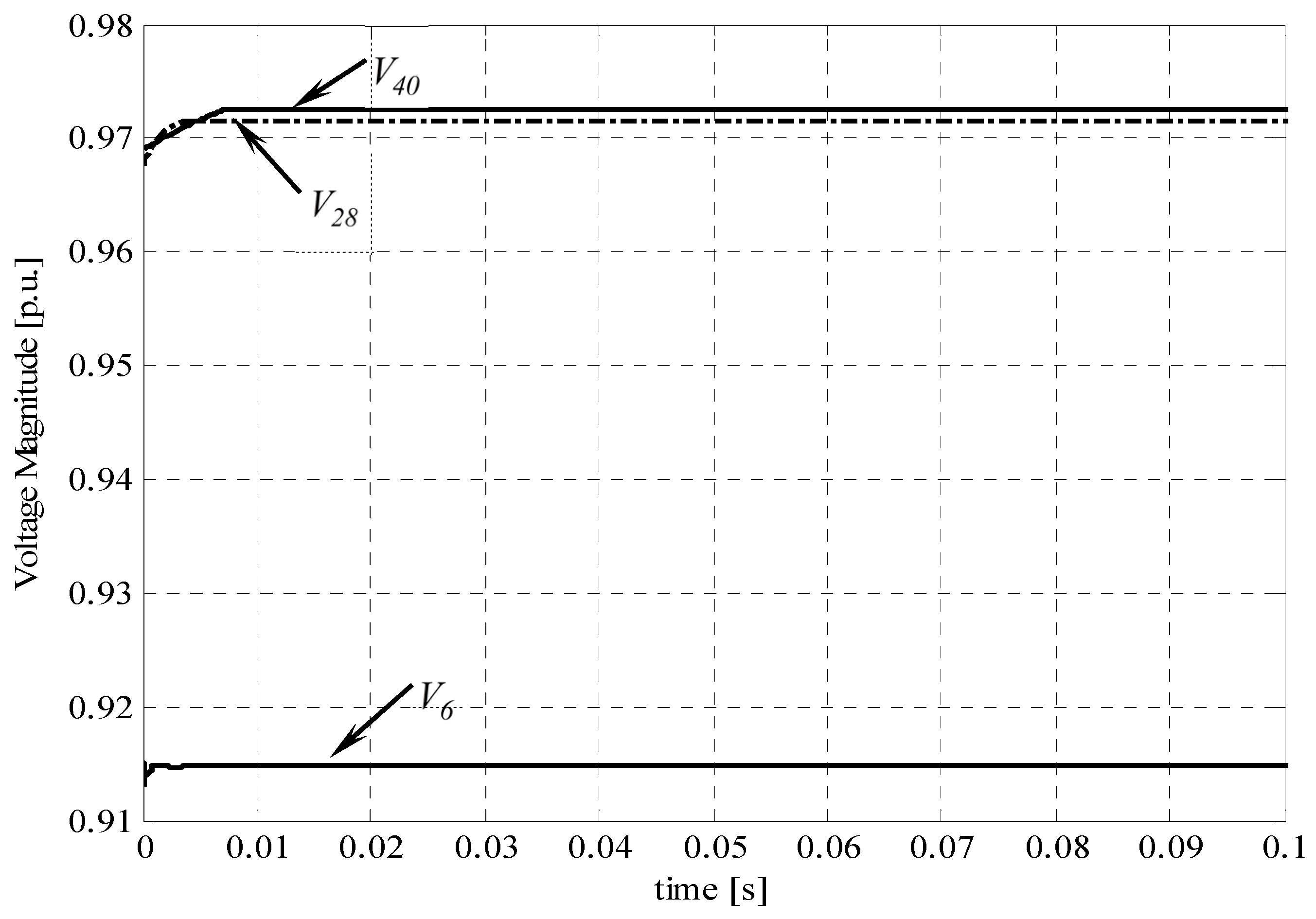
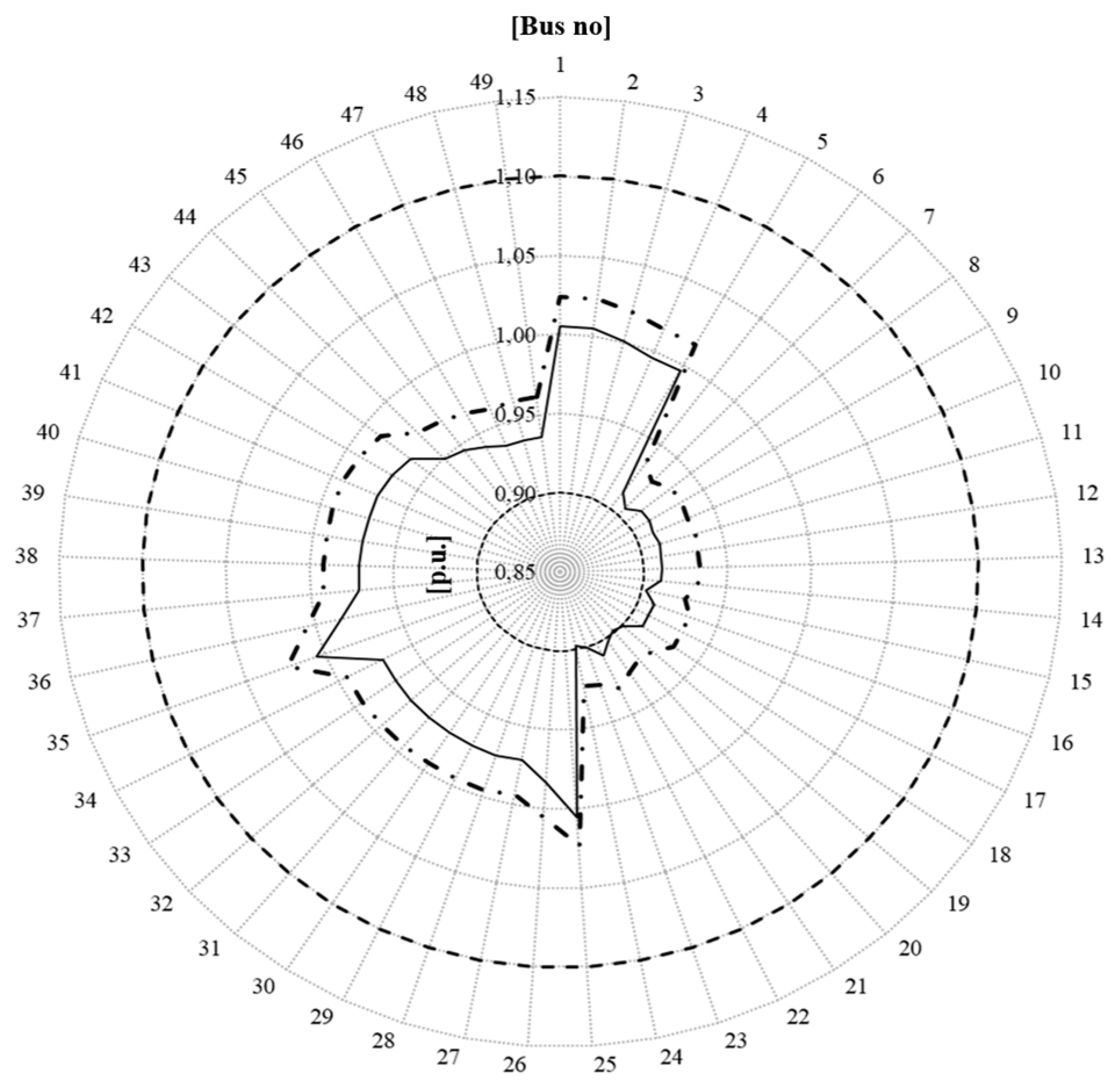

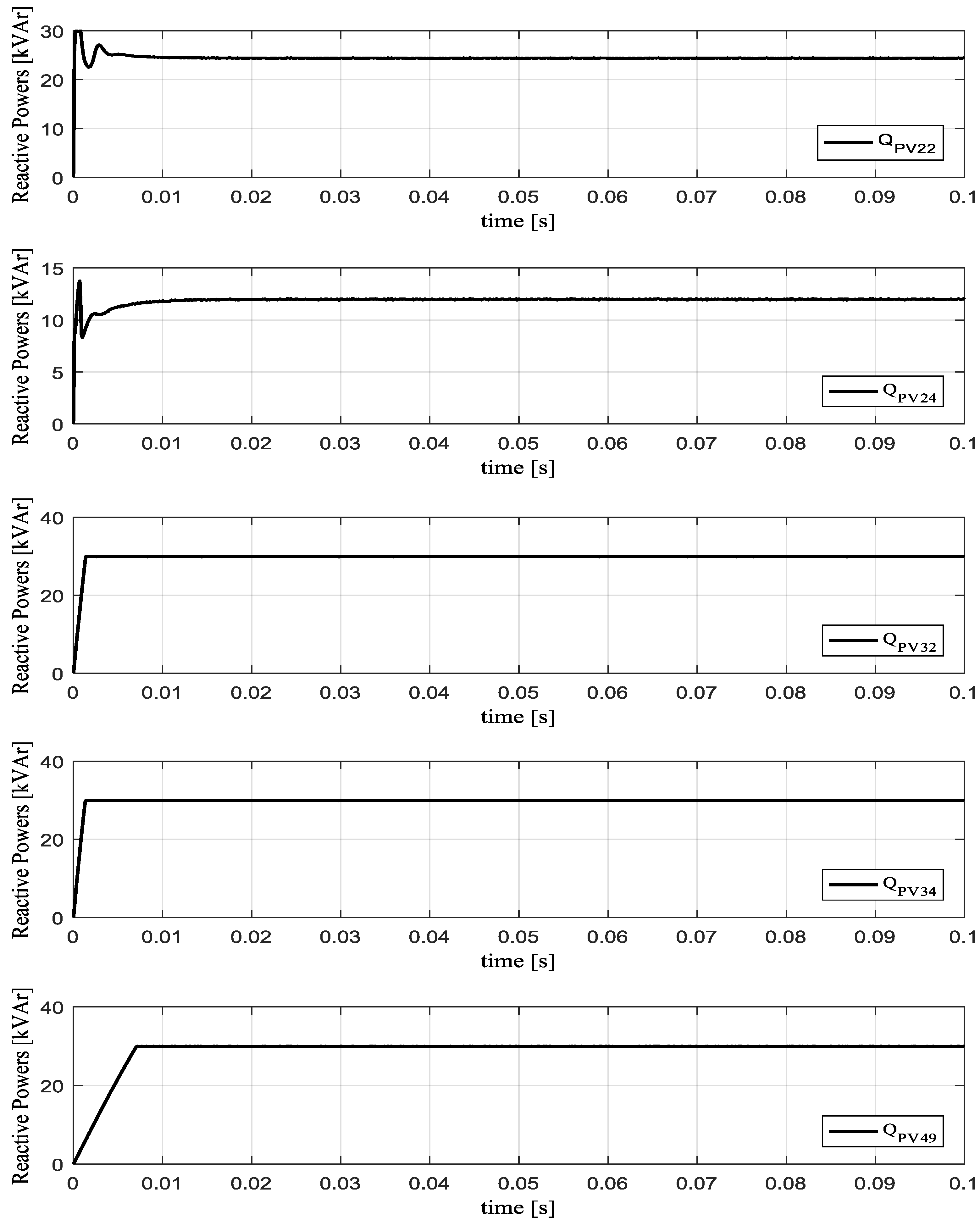
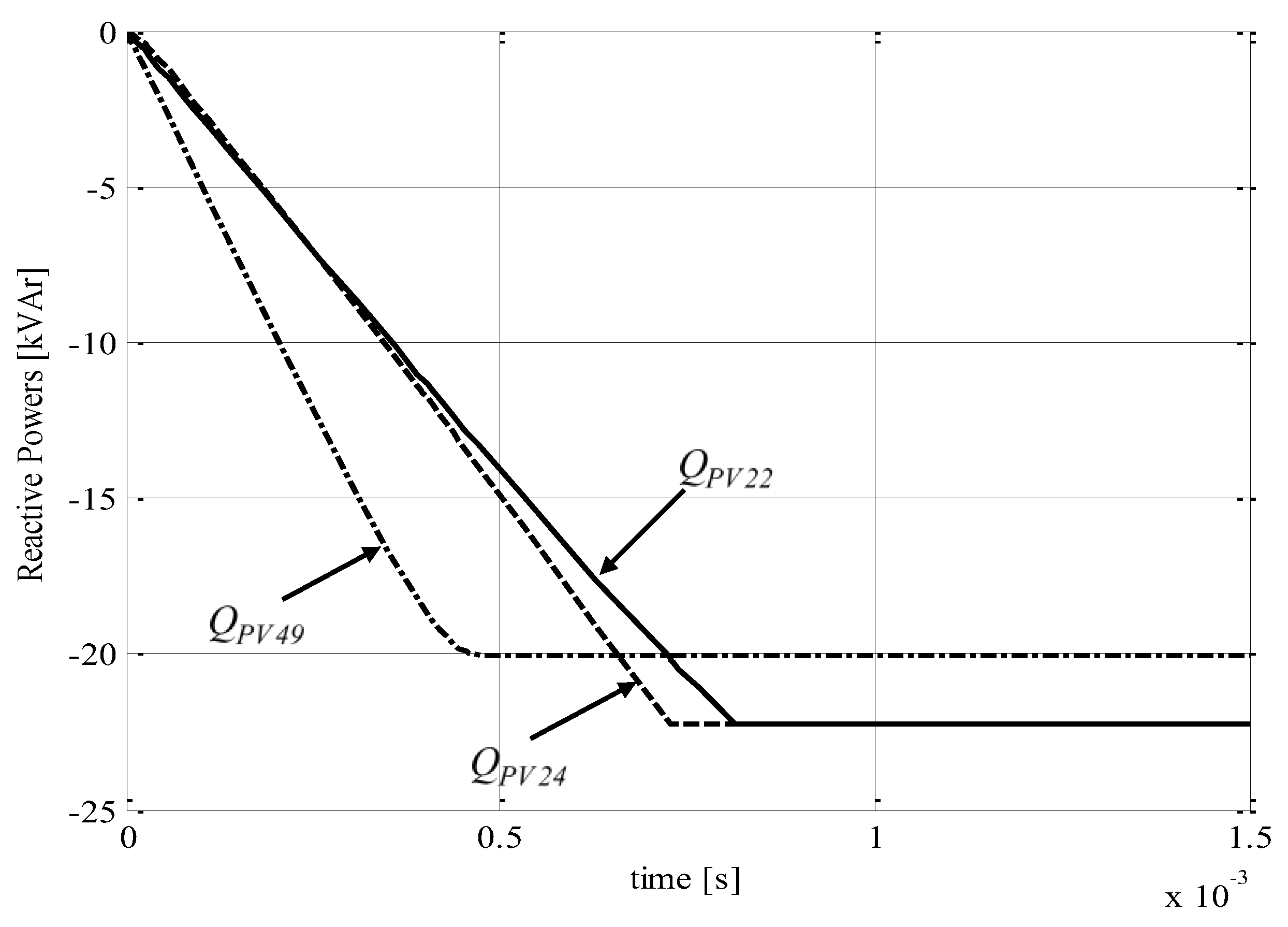
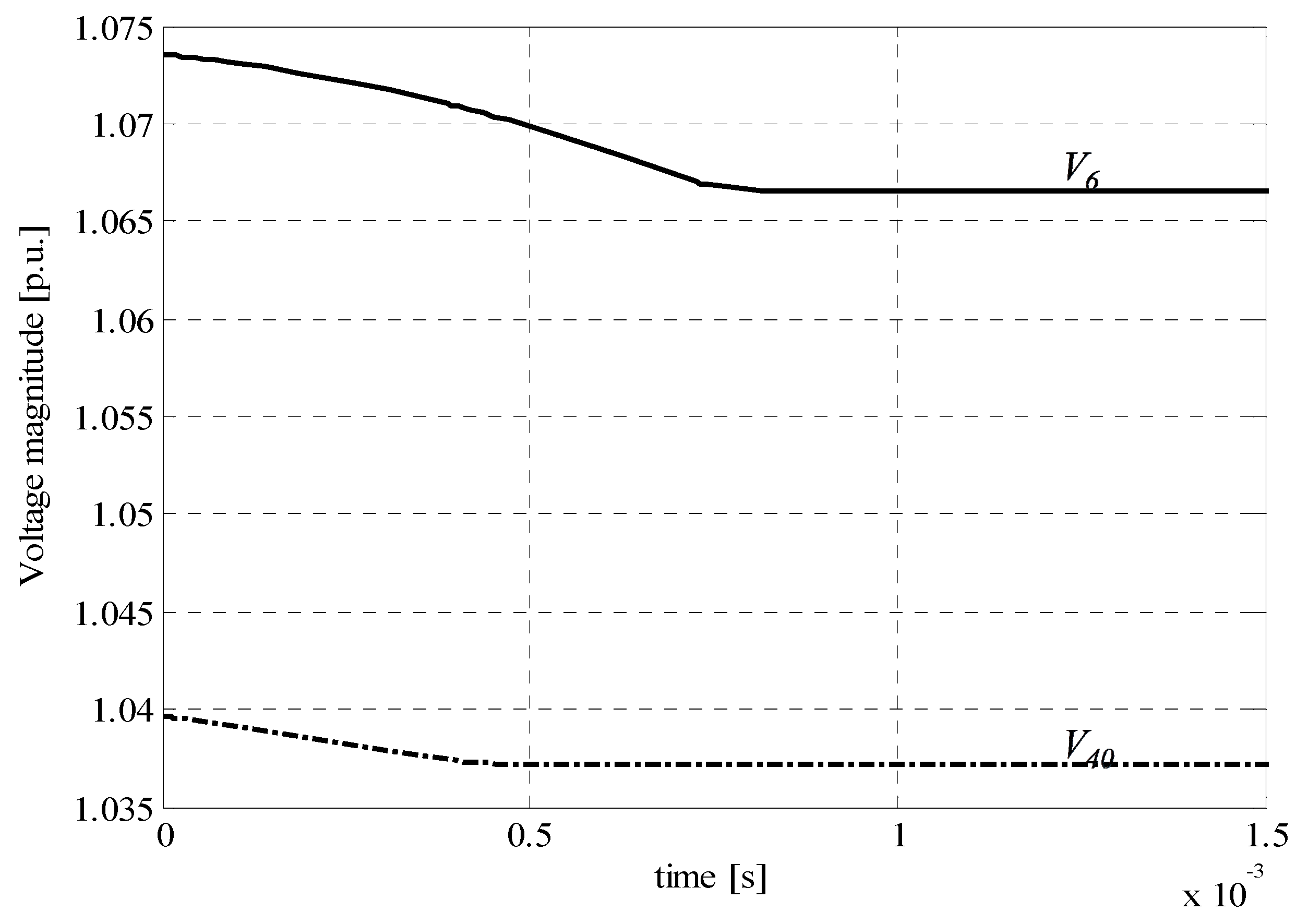

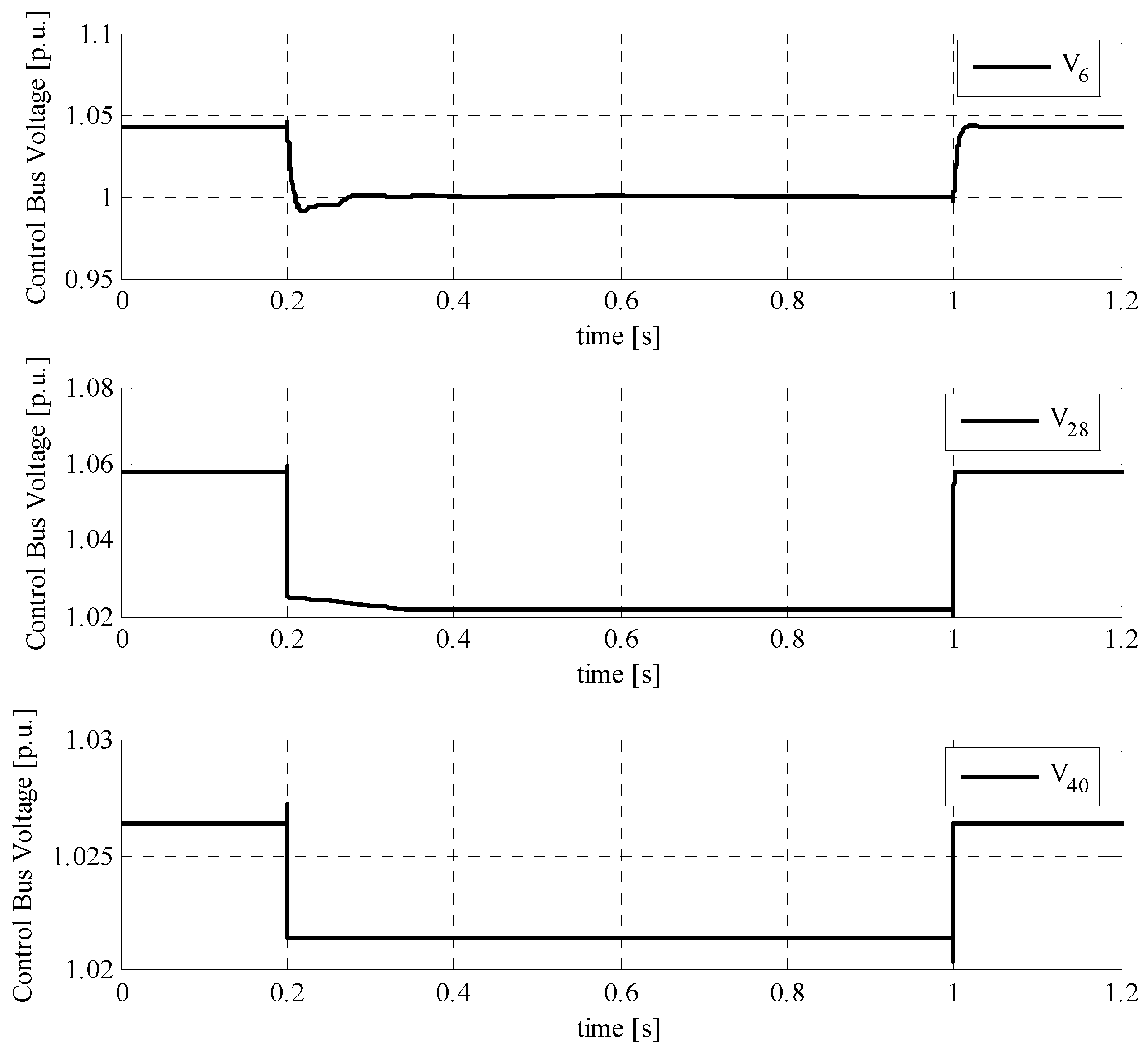
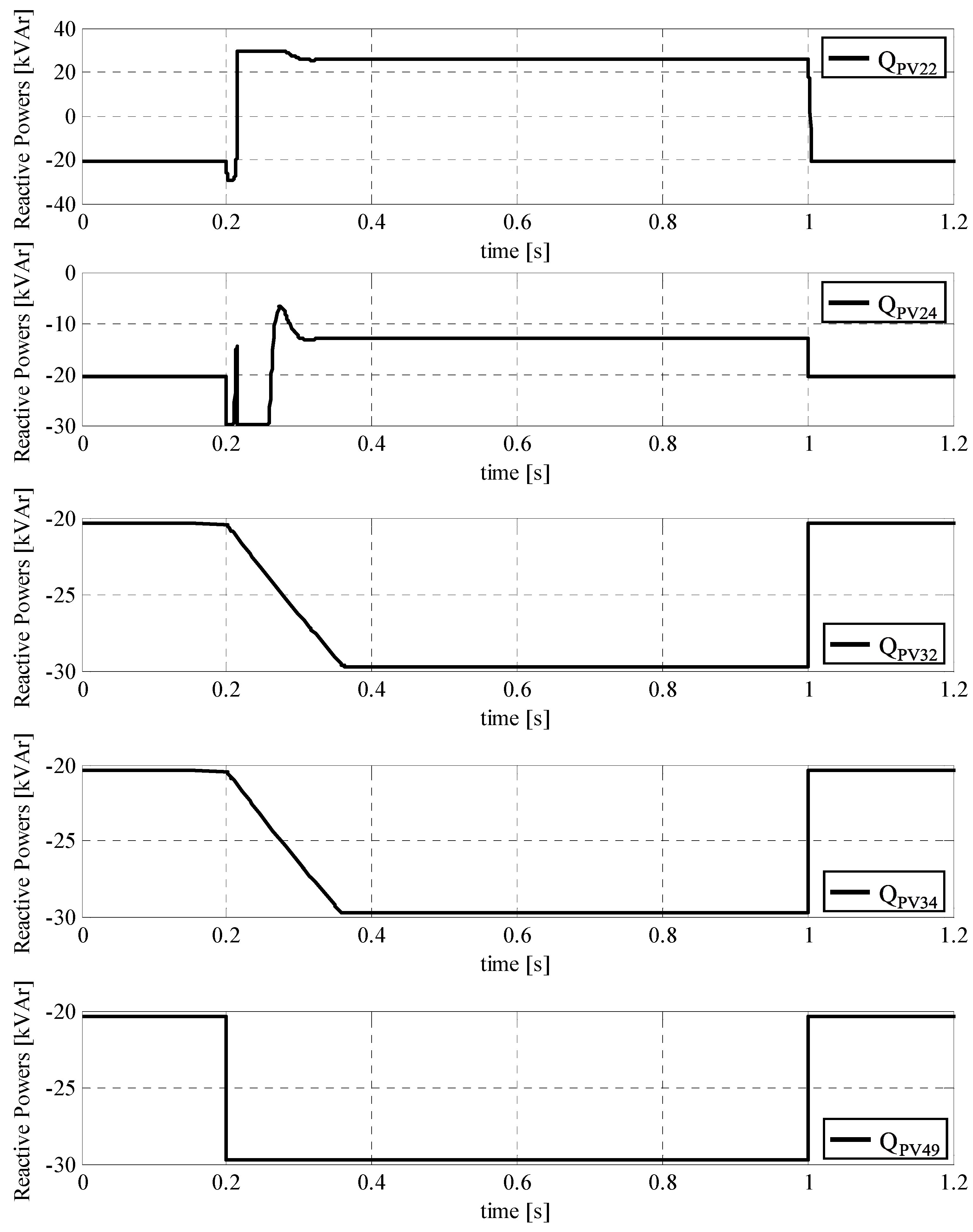
| Voltage Control Area | Sets of Buses Forming Voltage Control Areas | Control Buses | Boundary Area Nodes |
|---|---|---|---|
| Area 1 | 1–24 | 6 | 1, 6, 22, 24 |
| Area 2 | 1, 25–34 | 28 | 1, 28, 32, 34 |
| Area 3 | 1, 35–49 | 40 | 1, 40, 49 |
| Methodology | Reactive Powers [kVAr] | Performance Index Ψ | ||||
|---|---|---|---|---|---|---|
| Bus 22 | Bus 24 | Bus 32 | Bus 34 | Bus 49 | ||
| No voltage control | 0 | 0 | 0 | 0 | 0 | 0.290 |
| Centralized controller | 15.00 | 10.96 | 30.00 | 30.00 | 30.00 | 0.210 |
| Multi-Area controller | 21.57 | 10.76 | 30.00 | 30.00 | 30.00 | 0.226 |
© 2018 by the authors. Licensee MDPI, Basel, Switzerland. This article is an open access article distributed under the terms and conditions of the Creative Commons Attribution (CC BY) license (http://creativecommons.org/licenses/by/4.0/).
Share and Cite
Cagnano, A.; De Tuglie, E.; Bronzini, M. Multiarea Voltage Controller for Active Distribution Networks. Energies 2018, 11, 583. https://doi.org/10.3390/en11030583
Cagnano A, De Tuglie E, Bronzini M. Multiarea Voltage Controller for Active Distribution Networks. Energies. 2018; 11(3):583. https://doi.org/10.3390/en11030583
Chicago/Turabian StyleCagnano, Alessia, Enrico De Tuglie, and Marco Bronzini. 2018. "Multiarea Voltage Controller for Active Distribution Networks" Energies 11, no. 3: 583. https://doi.org/10.3390/en11030583





